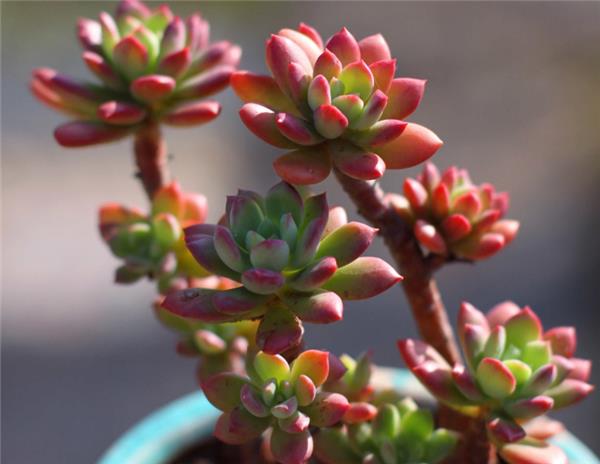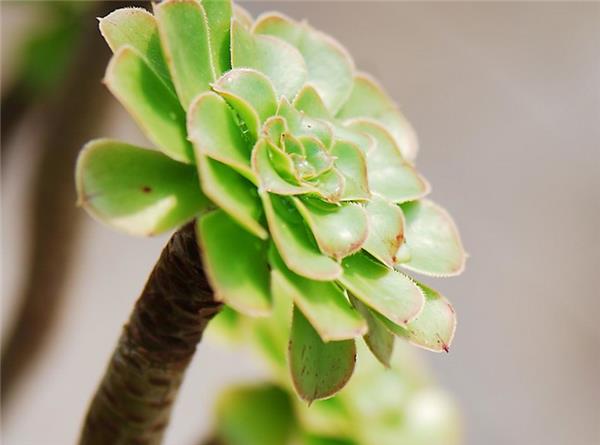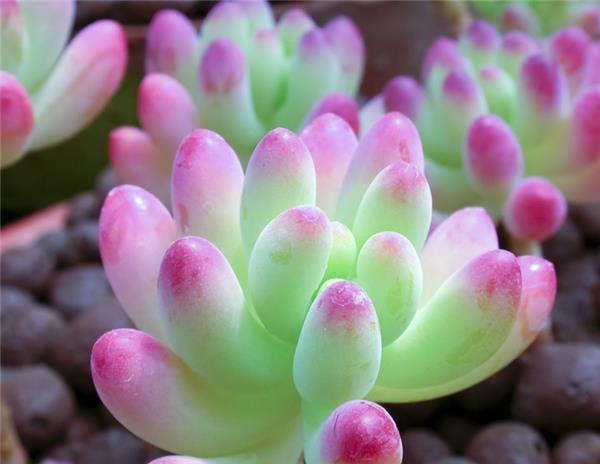Planting methods of succulent plants
Succulent plants look particularly lovely, thick leaves, fat branches, is the most powerful "cute brother" in the plant world, so do you know how to grow succulent plants? Let's take a look at the planting methods of succulent plants.

Planting methods of succulent plants
The cultivated soil requires loose air permeability and good drainage, but it has a certain water retention capacity and is neutral or slightly acidic. Highland globules (Yuehua jade, amber jade) and peony can add a little more rice chaff ash and small-grained weathered rocks. Tall columnar species can be mixed with large grains of quartz sand to fix the plant.
Transplanting and planting should generally take place during the recovery period just after the plant dormancy. Root should be trimmed before planting. After root trimming, you should hang it for a few days and then plant it with wet soil. After planting, do not rush to water the sun and do not apply fertilizer within a month.
For the regulation of temperature and light, cacti and succulent plants usually prefer warmth and a large diurnal temperature difference. Except for epiphytic cactus and 12-volume species, the light should be adequate, but soft. For this reason, except for a few flat stem nodes, tall columnar species and some tequila plants, they should be cultivated in the greenhouse all the year round. The types of epiphytic types should be shaded except in winter, combined with cooling in summer, and the degree of shading should be between 50% and 70%. Although epiphyllum and lotus have a certain degree of cold tolerance, keeping warm in winter is beneficial to blossom the following year. The measuring ruler, which is widely cultivated as a rootstock, is not cold-resistant and should maintain at least 5 ℃ in winter and require sufficient sunlight. Most terrestrial cacti grow most vigorously under the conditions of 28 ℃ to 35 ℃ in the daytime and 10 ℃ to 15 ℃ at night. When the indoor temperature is often higher than 35 ℃ to 38 ℃, the growth is stagnant, and some species of highland ball and pilose are easy to rot. Therefore, the temperature must be cooled, but the light should not be reduced as much as the epiphytic type. Most terrestrial types can withstand a low temperature of 2 ℃ or even 0 ℃ while keeping the basin soil dry in winter, but can not be exposed to snow directly by frost. Rosette species native to the Caribbean and globular species that bloom in winter are kept at higher temperatures. The succulent plants growing in summer can basically adjust the temperature with reference to terrestrial cacti. Their requirements for light are relatively low, and some species with expanded stem bases are not cold-resistant and should maintain a higher temperature in winter. Succulent plants growing in winter should be ventilated and cooled to keep cool during the summer dormancy period. Sufficient sunshine is required in winter, and the lowest temperature should be maintained above 7 ℃.

Watering and fertilization watering should be carried out according to its growth state. No matter the type of dormancy in winter or summer, stop watering the basin during the dormancy period. But the types of summer dormancy must be dried in aisles and other places to maintain a certain degree of air humidity. On the other hand, the plants in the vigorous growth period should fully meet their water demand. The seedlings should be watered more, but the big balls should be less (refers to the times); the terrestrial type should be watered less, and the epiphytic type should be watered more; the buds and blossoms should be watered more, the flowers and fruits laggard and less; the leaves with more and thinner leaves should be watered more, and the leaves with thicker but less leaves should be watered less. Fertilization should be carried out in the vigorous growth period and budding stage. Organic manure must be fully mature. When applying chemical fertilizer, the ratio of nitrogen, phosphorus and potassium is 5 ∶ 15 ∶ 10 or 5 ∶ 10 ∶ 10, and a small amount of trace elements should be mixed. The application of fertilizer is light but not thick, and can be applied several times when needed. Fertilization is prohibited for those with root injury, poor growth, stem and leaf injury and so on.
The prevention and control of diseases and insect pests is mainly based on prevention. First of all, the environment should be clean and tidy. Exotic plants must be strictly guarded and placed in the shed only when they are sure that there are no diseases and insect pests. The concentrated spraying in the shed in early winter, early spring and before Meiyu can get twice the result with half the effort. In addition, it has a good preventive effect on the disinfection of cultured soil. The commonly used agents are mainly fungicides for disease prevention and treatment (such as carbendazim, thiophanate, chlorothalonil, Dysen zinc, etc.) and insecticides (such as omethoate, acaryl alcohol, marathon, fenvalerate, etc.). The concentration of the insecticide should be controlled strictly according to the instructions, especially the insecticide, which will cause drug damage if the concentration is a little higher, which is particularly sensitive to Diguan and some Euphorbiaceae succulent plants. The spray must be sprayed several times in a row to be effective (2 days apart). The same kind of drug should be changed after being used twice. Long-term use of a pesticide is easy to produce drug resistance.

Finally, let's take a look at the rotten roots of succulent plants.
First, the root cause:
To some extent, the rotten roots of succulent plants are caused by too much watering or too much fertilization. Of course, the root rot of succulent plants is caused by many reasons, and the singleness of the soil will also cause rot. if the soil is breathable, then the excess water will flow down and will not cause flooding, especially in the rainy summer season. If the water is too much, it will cause plant roots to rot due to lack of oxygen to a certain extent, and poor ventilation after watering, which is also one of the reasons. Plants can often be loosened and ventilated in summer, which will be better. In addition, the tree protection general combined with Root Shitong capsule was used to effectively prevent and cure rot.

2. Solutions:
1. Pull out the meat and wash the roots and cut off all the moldy parts.
two。 Wipe off the wound and moldy area with carbendazim and then dry for about three days.
3. Re-root the processed meat, which can be hung at the mouth of the bottle and put water below but do not touch the root to promote the root; it can also be replanted in granular soil, such as red jade soil and deer marsh soil.
4. Put the meat planted or at the mouth of the bottle in a place with plenty of light indoors, do not expose yourself to direct sunlight, and pay attention to ventilation. You don't need to water immediately as soon as you plant it, but gradually stabilize it and then water it after it has grown. The next step is to observe carefully, if nothing happens, the root will grow again in one to three weeks.
In addition, do not rush to water the plants after they have roots, and the soil should remain permeable. In addition, watering should be carried out according to its growth state. No matter the type of dormancy in winter or summer, stop watering the basin during the dormancy period. But the types of summer dormancy must be dried in aisles and other places to maintain a certain degree of air humidity. On the other hand, the plants in the vigorous growth period should fully meet their water demand. The seedlings should be watered more, but the big balls should be less (refers to the times); the terrestrial type should be watered less, and the epiphytic type should be watered more; the buds and blossoms should be watered more, the flowers and fruits laggard and less; the leaves with more and thinner leaves should be watered more, and the leaves with thicker but less leaves should be watered less. At the same time, fertilization should be carried out in the vigorous growth period and budding stage.
If the water is too much, it will cause plant roots to rot due to lack of oxygen to a certain extent, and poor ventilation after watering, which is also one of the reasons. Plants can often be loosened and ventilated in summer, which will be better. In addition, the tree protection general combined with Root Shitong capsule was used to effectively prevent and cure rot.

2. Solutions:
1. Pull out the meat and wash the roots and cut off all the moldy parts.
two。 Wipe off the wound and moldy area with carbendazim and then dry for about three days.
3. Re-root the processed meat, which can be hung at the mouth of the bottle and put water below but do not touch the root to promote the root; it can also be replanted in granular soil, such as red jade soil and deer marsh soil.
4. Put the meat planted or at the mouth of the bottle in a place with plenty of light indoors, do not expose yourself to direct sunlight, and pay attention to ventilation. You don't need to water immediately as soon as you plant it, but gradually stabilize it and then water it after it has grown. The next step is to observe carefully, if nothing happens, the root will grow again in one to three weeks.
In addition, do not rush to water the plants after they have roots, and the soil should remain permeable. In addition, watering should be carried out according to its growth state. No matter the type of dormancy in winter or summer, stop watering the basin during the dormancy period. But the types of summer dormancy must be dried in aisles and other places to maintain a certain degree of air humidity. On the other hand, the plants in the vigorous growth period should fully meet their water demand. The seedlings should be watered more, but the big balls should be less (refers to the times); the terrestrial type should be watered less, and the epiphytic type should be watered more; the buds and blossoms should be watered more, the flowers and fruits laggard and less; the leaves with more and thinner leaves should be watered more, and the leaves with thicker but less leaves should be watered less. At the same time, fertilization should be carried out in the vigorous growth period and budding stage.
Related
- Wuhan Hospital Iron Tree Blooming Result Was Instantly Frightened by the Gardener Master
- Which variety of camellia is the most fragrant and best? Which one do you like best?
- What is the small blue coat, the breeding methods and matters needing attention of the succulent plant
- Dormancy time and maintenance management of succulent plants during dormancy
- Minas succulent how to raise, Minas succulent plant pictures
- What are the varieties of winter succulent plants
- How to raise succulent plants in twelve rolls? let's take a look at some experience of breeding twelve rolls.
- Attention should be paid to water control for succulent plants during dormant period (winter and summer)
- Watering experience of twelve rolls of succulent plants
- Techniques for fertilizing succulent plants. An article will let you know how to fertilize succulent plants.



